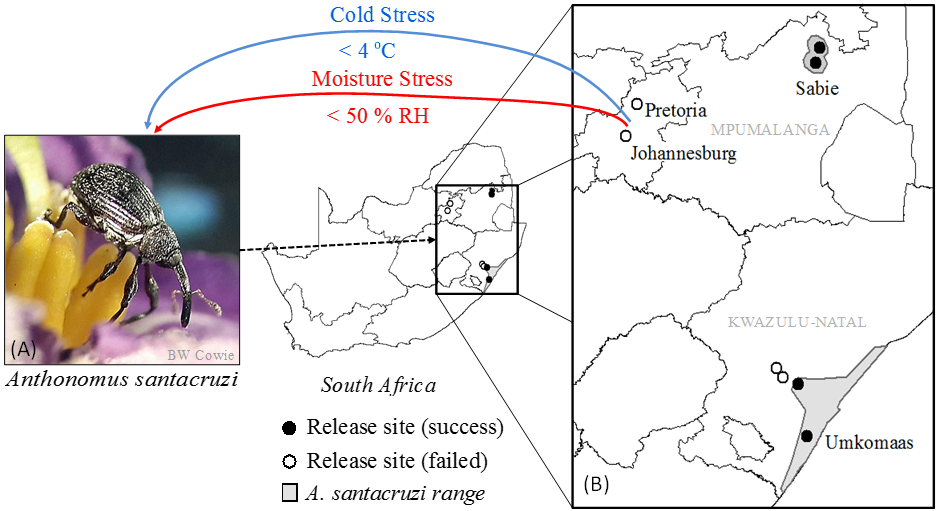18 October 2016 | By Blair Cowie
Two biological control agents maintain the potential to be effective agents against bugweed, after the incorporation of plant ecophysiology and climatic modelling in the assessment of their effectiveness. These findings come from two recent studies by MSc student, Blair Cowie, and C·I·B core team member, Marcus Byrne, both at University of Witwatersrand.
The invasive tree, bugweed (Solanum mauritianum), is a notorious invader in South Africa and has since the 1980s been targeted for biological control. Biological control of bugweed has a troubled history, particularly regarding the potential impacts of agents on native and cultivated Solanum species such as tomatoes, eggplant and potato.
These concerns have seen 15 potential agents rejected or shelved, and only two released to date include the sap-sucking lace-bug, Gargaphia decoris (released in 1999), and the flowerbud-feeding weevil, Anthonomus santacruzi (released in 2008).
In their first study, the authors examined the idea that light (full-sun or shade) could affect lace-bug feeding and plant responses. Experiments on leaf physiology, showed that lace-bug feeding was effective by reducing photosynthesis of bugweed under both full-sun and shade conditions. However, interestingly, plants in the sun experienced additional damage due to water loss, which caused them to suffer the effects of overheating. “This research suggests that the lace-bug has the potential to damage bugweed severely. Future research is needed to identify and address the biotic factors, such as predators, that currently constrain the agent’s performance in the field,” explains Cowie.
In a second study, the authors focussed on the more promising of the two agents, the flowerbud-feeding weevil, Anthonomus santacruzi. This weevil has not become as widespread as expected, but its establishment has been confirmed along the KwaZulu-Natal South Coast and in the Sabie region of Mpumalanga.
The authors combined climate modelling, thermal-physiology and humidity assessments to predict which climatic factors are most likely to restrict the establishment and spread of the weevils in South Africa. They found that low temperatures and low relative humidity, particularly during winter months, constrain the establishment of the flowerbud-feeding weevil in South Africa. “These results suggest that future releases of this agent should be focused in areas that are better suited to the species’ climatic requirements,” explains Cowie.
“This research highlights that the sap-sucking lace-bug and the flowerbud-feeding weevil maintain the potential to be effective agents against bugweed. These agents deserve renewed attention and investment in terms of their release strategies. The incorporation of plant ecophysiology and climate modelling offers additional techniques for the assessment of biocontrol agents’ efficacy”, says Cowie, lead author of the two papers published in Biological Control.
Read each of the papers in Biological Control
Cowie, B.W., Byrne, M.J., Witkowski, E.T.F., and Venter, N. 2016 Exacerbation of photosynthetic damage through increased heat-light stress resulting from Gargaphia decoris sap-feeding. Biological Control 94: 82-89. http://dx.doi.org/10.1016/j.biocontrol.2015.12.008
Cowie, B.W., Venturi, G., Witkowski, E.T.F., and Byrne, M.J. 2016. Does climate constrain the spread of Anthonomus santacruzi, a biological control agent of Solanum mauritianum, in South Africa? Biological Control 101: 1-8. http://dx.doi.org/10.1016/j.biocontrol.2016.06.005
For more information, contact Blair Cowie at blair.cowie.bc@gmail.com




